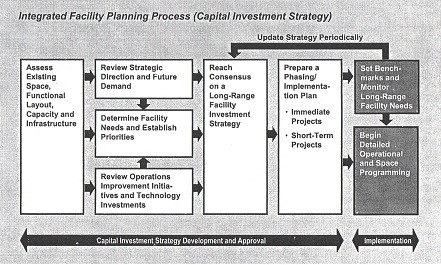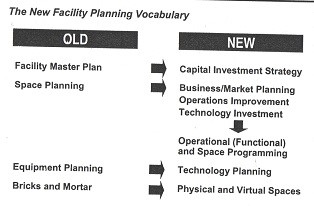RETHINKING THE FACILITY PLANNING PROCESS
Excerpted from: SpaceMed Guide: A Space Planning Guide for Healthcare Facilities
By: Cynthia Hayward
About The Author:

 Cynthia Hayward, AIA, is principal and founder of Hayward & Associates, LLC in Ann Arbor, Michigan, a national consulting firm specializing in predesign planning planning for healthcare facilities. She has assisted hundreds of diverse healthcare organizations over the past 25 years to economically and efficiently plan their capital investments. For 20 years, she was a partner with a healthcare management consulting firm (Chi Systems, Inc. which later became the Chi Group) until she founded Hayward & Associates. Her unique approach integrates facility planning with market demand analysis and clinical service planning, operations improvement, and investments in new equipment and information technology.
Cynthia Hayward, AIA, is principal and founder of Hayward & Associates, LLC in Ann Arbor, Michigan, a national consulting firm specializing in predesign planning planning for healthcare facilities. She has assisted hundreds of diverse healthcare organizations over the past 25 years to economically and efficiently plan their capital investments. For 20 years, she was a partner with a healthcare management consulting firm (Chi Systems, Inc. which later became the Chi Group) until she founded Hayward & Associates. Her unique approach integrates facility planning with market demand analysis and clinical service planning, operations improvement, and investments in new equipment and information technology.
In addition to her consulting activities, ms. Hayward has had a long history in research and development relative to healthcare facility planning. In the mid-1970’s, she was part of a team that was contracted by the U.S. Department of Health and Human Services to develop a generic healthcare planning process for hospitals across the United States. In the early 1980’s, she served as project director for a five –year contract with National Health and Welfare Canada to develop a series (Evaluation and Space Planning Methodology Series) of space planning methodologies for healthcare facilities which were used throughout North America over the subsequent decade.


Ms. Hayward is also the author of Healthcare Facility Planning: Thinking Strategically which is published by Health administration Press, a division of the Foundation of the American College of Healthcare Executives (http;/www.ache.org).
She has been a speaker at regional, national and international conferences on issues relating to pre-design planning and capital investment, including conferences sponsored by the American College of Healthcare Executives, Healthcare Financial Management Association, American Hospital Association, and the American Institute of Architects.
Ms. Hayward has a master of architecture degree from the University of Michigan and is a licensed architect (Michigan). She is also a fellow of the American Association of Healthcare Consultants and a founding member of the American College of Healthcare Architects.
RETHINKING THE FACILITY PLANNING PROCESS
Historically, facility planning was project-driven based on the wish-list of physicians and department managers. New facilities and large amounts of space were part of the “arms race” among physicians and between department managers, both internally and with competing organizations. There was little or no appreciation (or recognition in budgeting) of space as an expensive resource. Capital expenditures for facilities were often not coordinated with the institutes strategic planning initiative, operations redesign efforts, and planned information technology investments. The impact of facility investments on long term operational costs was often overlooked. Design and constructions specialists often focused on the construction or renovation project with little incentive to look for creative ways to avoid building. Facility projects were seldom views as part of an overall capital investment strategy for the institution.


After a lengthy facility master planning process, hospital boards deny many projects, not only because of the lack of capital, but because the impact on operational costs has not been identified. Projects are often postponed indefinitely or downsized and morale suffers as unmet expectations are communicated back to disillusioned physicians and department managers.
Today, successful healthcare organizations are deploying a more comprehensive, integrated facility planning process that begins with the strategic direction for the organization and incorporates clinical program planning, operations improvement, investments in new technology, and financial planning with facility master planning. Facility reconfiguration and new equipment should not be planned without a foundation of data and analyses including business plans for key clinical services, institution-wide operations improvement objectives, and understanding of the impact on operational costs (e.g. staffing, supplies), and coordination with the organization’s information technology strategic plan.

Rethinking the facility planning process also requires the use of new terminology. Just as strategic (market) planning has become more focused on financial viability, healthcare organizations rely on a capital investment strategy rather than the traditional facility master plan to balance the trade-offs between investments in new 
 bricks and mortar, medical equipment, and information technology. Space planning, particularly for a major clinical service line, cannot be accomplished without a business plan that describes the market dynamics, expected workload volumes (revenue), and ongoing operational costs – particularly staffing. Planned operational processes and new technologies to be deployed must also be defined and documented before space requirements can be determined. The term operational and space programming is often used in lieu of functional and space programming to emphasize the rigor that is required in rethinking operational processes before planning the physical space.
bricks and mortar, medical equipment, and information technology. Space planning, particularly for a major clinical service line, cannot be accomplished without a business plan that describes the market dynamics, expected workload volumes (revenue), and ongoing operational costs – particularly staffing. Planned operational processes and new technologies to be deployed must also be defined and documented before space requirements can be determined. The term operational and space programming is often used in lieu of functional and space programming to emphasize the rigor that is required in rethinking operational processes before planning the physical space.

Even the traditional equipment planning process has changed. Most major equipment items use digital technology that must be planned in conjunction in conjunction with the organizations overall information management strategy as part of technology planning. With electronic information exchange replacing the traditional flow of paper (and people), physical proximities that were once considered necessary are being reconsidered. The traditional bricks and mortar focus is being replaced by a combination of physical and virtual spaces.
0 thoughts on “Rethinking The Facility Planning Process”